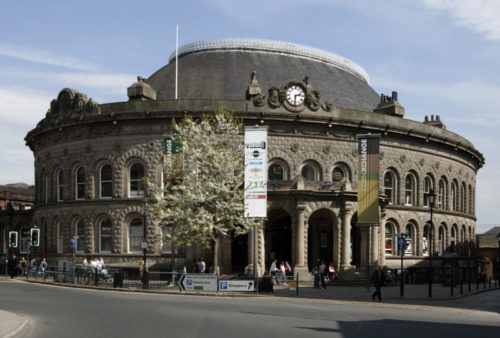The History of Leeds
Leeds became a major textile city in the 17th & 18th centuries. Whilst wool was still the main industry, flax, engineering, iron foundries and print works became major industries. The Leeds-Liverpool canal meant that goods could be produced, taken to port and exported globally. Agriculture also played a large role in the 19th century, demonstrated by the opening of the Corn Exchange in 1864.
During the Second World War, munitions were manufactured in the Yeadon airfield, now Leeds Bradford International Airport.
Leeds Today
The city boasts a diverse economy. The financial and legal sectors are the largest outside London. Media is becoming a large industry, now with Channel 4 headquarters based in Leeds. Leeds is also a hub for education, boasting 5 Universities.
Leeds boasts a diverse shopping district: high end stores mingle with independent traders, a large market as well as high street retailers.
Culture lovers enjoy the Leeds West Indian Carnival, and Leeds Festival takes place yearly in Bramham Park. Roundhay Park is an excellent outdoor space. The Royal Armouries also offers a fantastic day for history lovers. Elland Road is home to Leeds United FC. International Test Cricket takes place most summer’s at Headingly. Across the road from the cricket ground, is the Rugby League ground, Leeds Rhinos.
For Commuters
Leeds offers fantastic opportunities for commuters. Road links to the M1, M62, M621, A1, and A63 & A64 mean that drivers can be heading north, south, east or west in less than 15 minutes.
Things To Consider When Buying a Property in Leeds
Whilst not exhaustive, the below information indicates what you should look out for when purchasing property in or around Leeds.
Conservation Area
Certain parts of the city are covered by Conservation Areas. Conservation areas are designed to protect areas of significant historical value, from harmful change, encouraging good quality design in new developments. Any buildings within conservation areas are protected from unauthorised demolition. New development also has to respond to the historic settings. Trees are also protected in conservation areas.
Planning permission is required for certain external works to a house within a conversation area, which wouldn’t normally need planning permission elsewhere. Conservation areas mean extra care, planning controls and considerations if you wish to extend or change your property or garden. This is in keeping with the original historic architectural settings.
Conservation area restrictions will affect any owners who are seeking to work on the outside of their home or garden. The local planning authority is the organisation to seek if you wish to change or adapt your home in a conservation area. They will explain what permissions will be needed.
Flood Risk
The River Aire, Calder & Hebble Navigation Canals & Leeds-Liverpool Canals have caused damage to the city in recent years. Many locals remember the Boxing Day floods of 2015. Since then, some properties may be categorised as being in a High Flood Risk area, which makes obtaining a mortgage or buildings insurance difficult. You should be mindful of this when purchasing in the area.
We strongly recommend that a good quality, reliable Environmental Search is carried out when purchasing in Leeds, especially if the property you are buying is within close proximity to a river or canal, the Kirkstall area which was affected by the Boxing Day flooding.
Whilst we cannot comment on the results, we would recommend that where a moderate-high flood risk is found in Leeds or flooding has occurred in the property you are purchasing, you report this to your proposed Buildings Insurer to ensure that you will still be able to obtain insurance on standard terms.
Particular attention should be paid to the Property Information Form and what the seller has had to say about flooding. This form also gives information on buildings insurance claims, which may have been made as a result of a flood.
Listed Buildings
You may find that the property you are purchasing is listed. This means that it has been placed on one of the four statutory lists maintained by Historic England. A listed building may not be demolished, extended or altered without special permission from the planning authority, which normally involves a central Government agency. A National Amenity Society must be notified of any works which involve demolition.
Bridges, monuments, war memorials, sculptures and other such items could be listed and so great care is required. Criminal prosecution can follow for unauthorised works or demolition of a listed building or structure.
The procedure for works to any listing building can be strict and onerous, and so you need to be aware of what you are buying if the Property is listed.
We highly recommend a Local Authority Search to be carried out for all properties within the York & North Yorkshire area, to ensure that we can flag up and advise of any potential listed building status.
Article 4 Direction
You may find that the Local Authority Search you conduct shows an Article 4 Direction. This is a piece of legislation used to restrict development. The main thing to consider if your property has this on is that permitted development will be restricted.
This means you will have to apply for planning permission for most if not all works you wish to carry out which in other areas may not have required it. The addition of a conservatory is a good example.
We recommend that a good quality Local Authority search is carried out and consult your Solicitor if you are planning any developments or extensions to a property in the Leeds area.
Clean Air Zone
Large parts of Leeds are the subject of a Smoke Control Order, making it a Clean Air Zone. These aim to address pollution and reduce public exposure to them, using a range of measures tailored to the location.
- Non-Charging Clean Air Zones- These are defined geographic areas used as a focus for action to improve air quality.
- Charging Clean Air Zones- In addition to the above, vehicle owners are required to pay a charge to enter or move within the zone, if they are driving a vehicle which doesn’t meet emissions standards.
Leeds City Council has proposals in order to reduce air pollution. These are constantly under review. Up to date Local Authority Searches are recommended.
Mining Searches
Mining Searches are designed to find out if there has been any past, present or future mining activities planned in the vicinity of your property. The report also details whether a property is in a former coal mining area. A report provides information on:
- mine entries within 20 meters of a property’s boundaries
- gas emissions from coal mines
- other coal mining hazards reported in the area
- plans for future coal mining in the area
The importance of mining searches cannot be understated. Properties near past mining activities may be at risk of being on unstable ground and may suffer movement, also known as subsidence. We conduct the mining search on your behalf with the report usually taking a couple of days to process.
Planning & Infrastructure Report
Leeds has a lot of development. Many buildings have renovations planned and there are many new high rise apartment and office blocks. A planning report would be advised. This would check whether there are any small, medium or large developments within the vicinity of the property or which may affect your enjoyment of the property.
Leeds is planned to be a hub of HS2 and so such a report would tell how far the station or line would be from your chosen property and how this may affect you. HS2 aside, Leeds City Station has undergone a major renovation and is seen as a hub of the north as part of the Northern Powerhouse project.
As such, you should check the vicinity of any current or planned rail track to your property. Any track or tunnel within 400m of the property generally needs to be reported to your mortgage lender.
Call us on 0113 284 5000 or email a member of the residential property team for your free advice.


















